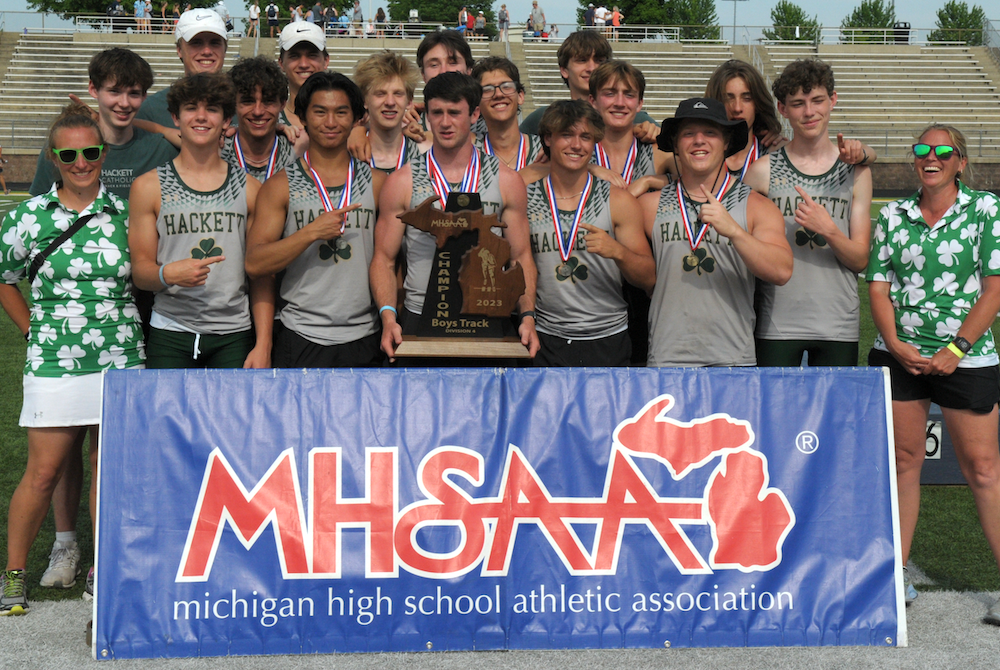
Thrower Claims Lone Individual Title to Lead Hackett to Team 3-Peat
By
Tom Lang
Special for MHSAA.com
June 3, 2023
Kalamazoo Hackett Catholic Prep just keeps winning and winning.
This time the Irish took home their fourth title in the last five Lower Peninsula Division 4 Track & Field Finals, on Saturday at Hudsonville.
Hackett’s only individual title was taken by discus winner Nathan Buchmann, a senior, who was fine knowing he was the shortest in stature among all the sizable competitors.
“In the offseason after football I worked out every day, working towards this goal,” he said after getting his medal. “I would say this takes 80 percent technique and 20 percent strength to throw the discus. So, length can help but if you have good technique and are really strong, that will play into it.
“I think we are very balanced throughout the meet today,” he said about teammates that scored points in finishes other than first place. “We have 13 guys here today, and we have people in a lot of the races. But I do not run; I have too short of legs to be a fast runner,” he said with a chuckle.
Buchmann had to work through a hip injury to compete this spring.
“I think the setbacks are what make you strong,” he said. “You can either give up through the setbacks or push forward and become better.”
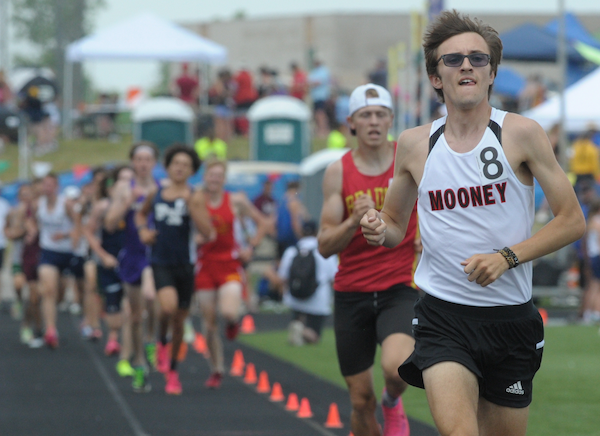 Coach Charissa Dean agreed.
Coach Charissa Dean agreed.
“The kids have big hearts,” she said after all the points were totaled and the Irish were on top once again, with 53. “They worked hard. They had a lot of potential when we started the season. And we had a lot of drive to put in the work, and we are happy the results came out the way they did.”
Reading was runner-up at 47 points, followed by Wyoming Potter’s House Christian with 42, then Fowler and Flint Beecher each with 37 points.
Senior Lezawe “Moses” Osterink, of Potter’s House Christian, placed second in 1,600 but took the 3,200 title as defending champ of both. He dominated the latter by lapping the field with a final lap kick that resembled more of a superhero speedster.
“Nobody really took it out that hard at the start,” he said. “There was a freshman (Marek Butkiewicz of Hackett) that tried to get the pace going quick, but me and Dakota (Dykhuis of Montabella) just kind of sat back and gradually pulled him through.
“We took it gradually, and I was just relying that I could kick.”
Kick did he ever. The trio were neck and neck the majority of the race in a grouping ahead of the pack.
“With 400 to go I just tried to go all out,” Osterink said. “I had a lot more left than I thought and I was pleased with the win. Not really the time, but that doesn’t matter, especially this hot out.”
The overall meet was in the low 90s/high 80s heat and searing sun all day. So, race officials allowed the unique opportunity for coaches to spray the runners with water and give them water bottles.
“It was very weird because I’ve never taken water to drink while I’m running, so I didn’t know how that would feel,” Osterink said. “And they were spraying us and hitting us in the face. It was kind of fun.”
Junior Tyler Lenn of Marine City Cardinal Mooney defeated Osterink at his own game in the 1,600.
“I’m feeling great,” Lenn said after grabbing the medal. “I said to a newspaper after one of my races (during the season) I was right where I wanted to be. This has been a long rebuilding process for me since an injury back in the fall, and I set a pretty high goal the day the injury happened. I was telling myself I needed to fulfill what I said I would do at the beginning of last cross country season. And that is what I did today.”
Lenn suffered an ankle sprain from a misstep that turned worse because he kept running through the season on it.
“Coming back from that was pretty tough, but I wouldn’t have it any other way,” he said. 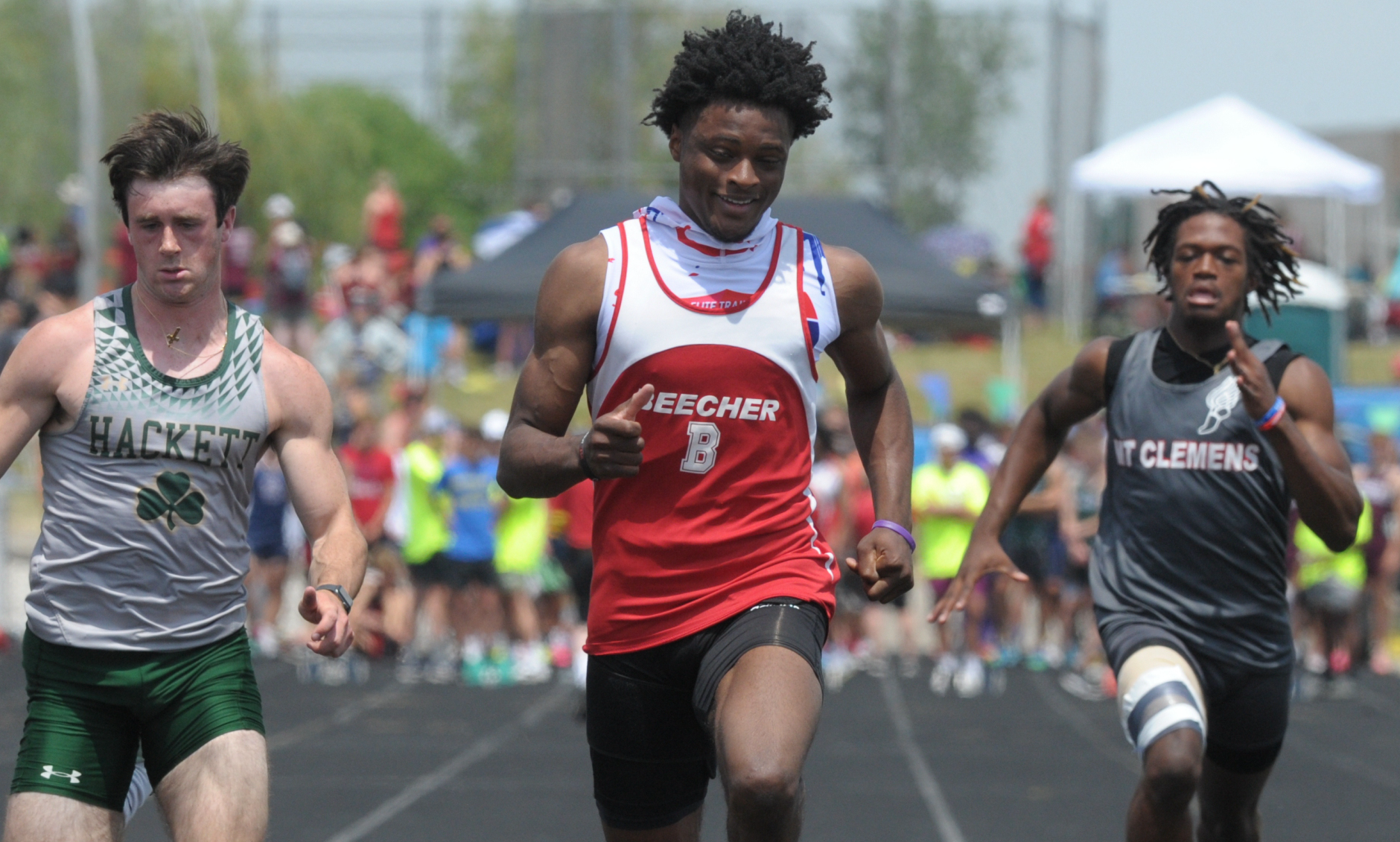 “Perseverance; I said from the beginning what I was going to do. I kept my eye on that target, and no matter the circumstances life threw at me, that I was going to make it happen and I am a man of my word.”
“Perseverance; I said from the beginning what I was going to do. I kept my eye on that target, and no matter the circumstances life threw at me, that I was going to make it happen and I am a man of my word.”
Jaylin Townsend, a senior from Flint Beecher, dominated the short races. He won the 100 dash (10.67) and 200 dash at 22 seconds flat. It was his third 100 win at a Finals.
“I put in a lot of work; I had to three-peat,” he said after the 100. “There’s a lot of great competition here, so I knew I had to come out and run my best.”
Concord in the 400 (43.72), Buckley in the 800 (1:30.76) and 1,600 (3:29.13) and Potter’s House in the 3,200 (8:14.18) were relay champs Saturday. Reading’s Tayshawn Bester won the 110 hurdles (15.13), and Athens’ Landen Bennett won the 300 (39.85). Caseville’s Nathan Feltner won the 400 (50.76), and Vestaburg’s Owen Patton claimed the 800 (1:55.11).
Fruitport Calvary Christian’s Bradley Richards won the high jump (6-10), and Peck’s Alex Affer won the long jump (23-4). McBain Northern Michigan Christian’s Isaac Bowden was first in pole vault (13-0), and Brown City’s Kyle Affer won shot put (49-2).
PHOTOS (Top) Kalamazoo Hackett Catholic Prep celebrates its third-straight LPD4 title Saturday. (Middle) Cardinal Mooney's Tyler Lenn, far right, sets the pace in the 1,600. (Below) Flint Beecher's Jaylin Townsend, middle, crosses the finish first for one of his two sprint championships. (Photos by Ken Swart/RunMichigan.com.)
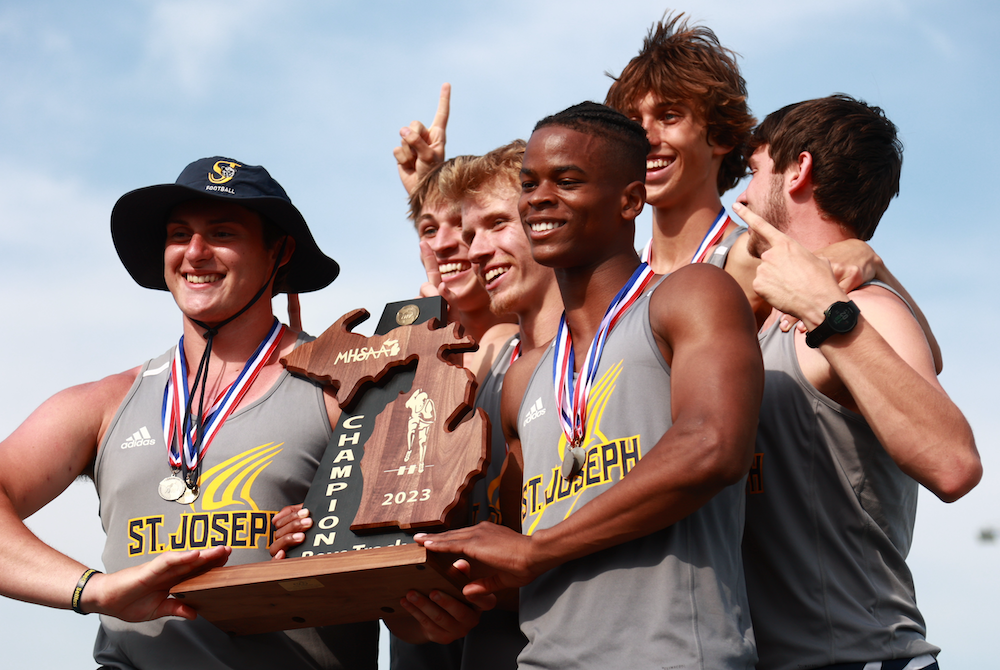
St. Joseph Boys Make Every Point Count in Clinching 1st Finals Since 1997
By
Keith Dunlap
Special for MHSAA.com
June 3, 2023
ROCKFORD – Entering the final event of Saturday’s Lower Peninsula Division 1 Final, the 1,600 relay, St. Joseph was in first place – but by the slimmest of margins.
St. Joseph had 35.75 points, while Rockford had 35, Clinton Township Chippewa Valley had 32, and Ann Arbor Huron had 30.
Bears head coach Todd Rose knew his team was in the second heat before faster teams after, but his for sure needed to be faster than Rockford.
“I don’t teach them to worry about who they are running against,” Rose said. “Just run within themselves and run how we teach them.”
St. Joseph did that behind the team of Shay White, Will Fiesbeck, Eli Toney and Alex Moyer, finishing fourth in the event with a time of 3:21.50 to earn a meet-best 40.75 points – clinching the program’s first Finals team championship since 1997.
Chippewa Valley was runner-up with 38 points, while Rockford was third at 36 points.
St. Joseph senior Gerald Capaccio scored 18 precious points for his team, most notably winning the discus with a winning throw of 167-2. Capaccio said he was in second going into his last throw.
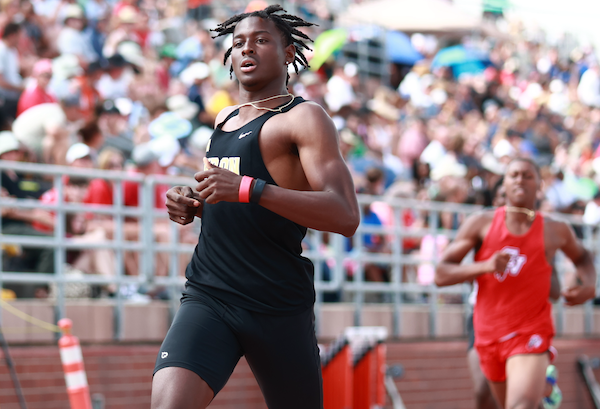 “I just had the mindset that everyone can have a big throw, and it just has to be me that gets the big throw,” Capaccio said. “It happened on my final throw.”
“I just had the mindset that everyone can have a big throw, and it just has to be me that gets the big throw,” Capaccio said. “It happened on my final throw.”
Capaccio also was second in the shot put with a throw of 56-11¼.
In addition to Capaccio earning big points in the shot put and discus, Rose gave credit to high jumper Joshua Scott for finishing in a tie for seventh in that event. That gave the Bears two points, and they proved to be especially important as the team won by less than one.
It’s rare when a runner does something that hasn’t been achieved since before automobiles were invented, but Ann Arbor Huron senior Braxton Brann had that distinction.
Brann won the 110 hurdles and the 200 dash, becoming the first athlete to win those two events at the same state meet since 1895 – three decades before the MHSAA was formed.
“It’s great to be in that kind of conversation,” said Brann, who will run in college at Ohio State.
First, Brann won the 110 hurdles in a time of 13.77. He said that was the event he was most concerned about.
“I haven’t really been consistent, so I just wanted to be that,” Brann said.
Feeling much more comfortable and at home in the 200 dash, Brann ran a winning time of 21.12.
“Everybody comes in looking at the stats of everybody else,” he said. “I saw I was in the best position to win. But I knew I had to run by butt off against this great field and come out with a win.”
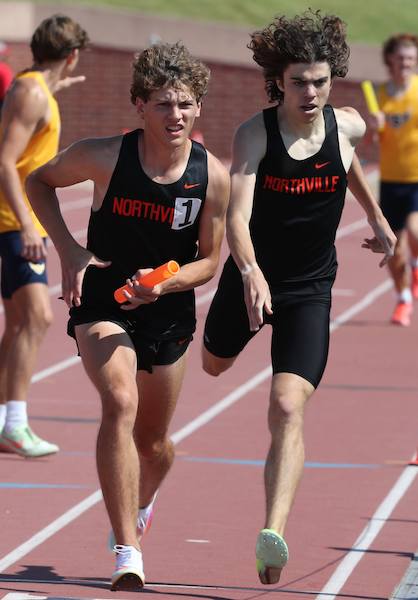 Just about everyone in the stadium did a double-take when Northville’s 3,200 relay time was posted. The team of Brandon Latta, Brock Malaikal, David Whitaker and Brendan Herger set a new all-Finals record with a blistering time of 7:35.32, which was the best time in the nation this year.
Just about everyone in the stadium did a double-take when Northville’s 3,200 relay time was posted. The team of Brandon Latta, Brock Malaikal, David Whitaker and Brendan Herger set a new all-Finals record with a blistering time of 7:35.32, which was the best time in the nation this year.
Herger said when he got the baton on the anchor leg, he knew his teammates set him up incredibly well. But even he and Northville couldn’t have foreseen this.
“I had to run 1.54 to get it, and then I ended up running a bit faster than that,” Herger said. “I was so happy. I love my boys so much. It was great to share the moment together.
Herger also ended up finishing second in the 800 meters with a time of 1:52.19 behind Utica’s Trent McFarland.
Detroit U-D Jesuit senior Jaiden Reed won the 100 (10.74), and Clinton Township Chippewa Valley junior Shamar Heard won the 400 (47.78). Grand Rapids Ottawa Hills senior Benne Anderson won the 1,600 (4:05.44), and Grand Haven junior Seth Norder won the 3,200 (9:04.68). Kalamazoo Central senior Kayenn Mabin won the 300 hurdles (38.31). Rockford in the 400 (42.01), Chippewa Valley in the 800 (1:26.41) and Oak Park in the 1,600 (3:18.90) also won relay titles.
Battle Creek Lakeview senior Andrew Berryhill was champion in the shot put (58-¼), and Saline senior Dolan Gonzales won pole vault (16-0). Ann Arbor Huron junior Andrew Harding won the high jump (6-7), and Canton sophomore Quincy Isaac won the long jump (22-11). New Baltimore Anchor Bay sophomore Luke Bowman competed in the adaptive 100 (19.65), 200 (35.66) and 400 (1:14.39).
PHOTOS (Top) St. Joseph celebrates its LPD1 championship Saturday. (Middle) Ann Arbor Huron's Braxton Brann finishes one of his two race wins. (Below) Northville makes the final exchange of its record-setting 3,200 relay. (Photos by Jamie McNinch [top two photos] and Carter Sherline/RunMichigan.com.)

